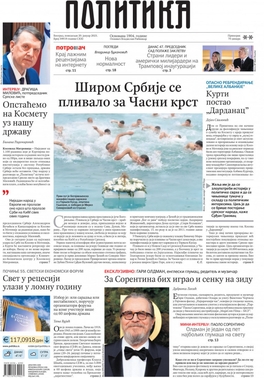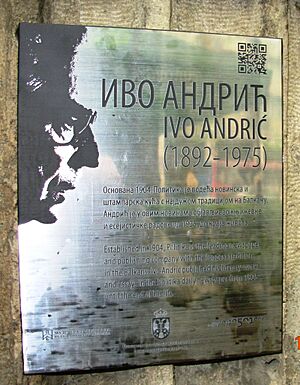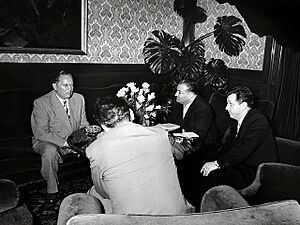Politika facts for kids
 |
|
 |
|
| Type | Daily newspaper |
|---|---|
| Format | Berliner |
| Owner(s) | Politika a.d. (50%) East Media Group (50%) |
| Founder(s) | Vladislav F. Ribnikar |
| Publisher | Politika novine i magazini d.o.o. |
| Founded | 25 January [O.S. 12 January] 1904 |
| Language | Serbian |
| Headquarters | Politika Square 1, Belgrade |
| Country | Serbia |
| Circulation | ~45,000 (as of 2016) |
| ISSN | 0350-4395 |
| OCLC number | 231040838 |
Politika (which means "Politics" in Serbian) is a daily newspaper from Serbia. It is published in Belgrade. This newspaper was started in 1904 by Vladislav F. Ribnikar. It is the oldest daily newspaper that is still being published in the Balkans region.
Contents
About Politika: A Serbian Newspaper
Politika is published by a company called Politika novine i magazini (PNM). This company is a partnership between Politika a.d. and East Media Group. The current director of PNM is Mira Glišić Simić.
Other Publications by PNM
PNM also publishes other popular magazines and newspapers. These include:
- Sportski žurnal (a sports newspaper)
- Politikin Zabavnik (a popular weekly magazine for young people)
- Svet kompjutera (a magazine about computers)
- Ilustrovana Politika (an illustrated magazine)
- Bazar (a lifestyle magazine)
The History of Politika Newspaper
Politika started publishing in January 1904. It has been published every day since then, except for a few times.
Times When Politika Was Not Published
- During World War I, the newspaper stopped publishing for a short time in 1914. It also stopped from September 1915 to December 1919.
- During World War II, Politika was not published from April 1941 to October 1944.
- In the summer of 1992, one issue was not published. This was a protest against the government's plans to make Politika a state-owned enterprise.
When it first started, the newspaper had only four pages. It printed 2,450 copies. Its highest number of copies printed was on December 25, 1973. On that day, 634,000 copies were printed!
Politika During the Yugoslav Wars
During the time of the breakup of Yugoslavia and the Yugoslav Wars, Politika was sometimes used to share information that was not always fair or true. It published stories that supported certain political views and sometimes spread claims that were later found to be incorrect. For example, it published articles that were later retracted, meaning they were taken back because they were not accurate.
Politika After the Wars
An organization of investigative journalists called KRIK reported on Politika in 2024. They found that the newspaper published many articles that were biased or not based on facts.
Important People at Politika
Politika has had many important people work for it over the years.
Editors of Politika
The editor is the person in charge of what goes into the newspaper. Here are some of the main editors:
- Vladislav F. Ribnikar (1904–1915)
- Miomir Milenović and Jovan Tanović (1915–1941)
- Živorad Minović (1985–1991)
- Aleksandar Prlja (1991–1994)
- Boško Jakšić (1994)
- Dragan Hadži Antić (1994–2000)
- Vojin Partonić (2000–2001)
- Milan Mišić (2001–2005)
- Ljiljana Smajlović (2005–2008)
- Radmilo Kljajić (2008)
- Dragan Bujošević (2008–2013)
- Ljiljana Smajlović (2013–2016)
- Žarko Rakić (2016–2021)
- Marko Albunović (since 2021)
Other People Who Worked There

Many famous writers and journalists have worked for Politika. Some of them include:
- Verica Rupar, a journalist
- Hamza Humo, a writer
- Ivo Andrić, a famous writer
- Zija Dizdarević, a journalist
See also
 In Spanish: Politika para niños
In Spanish: Politika para niños


